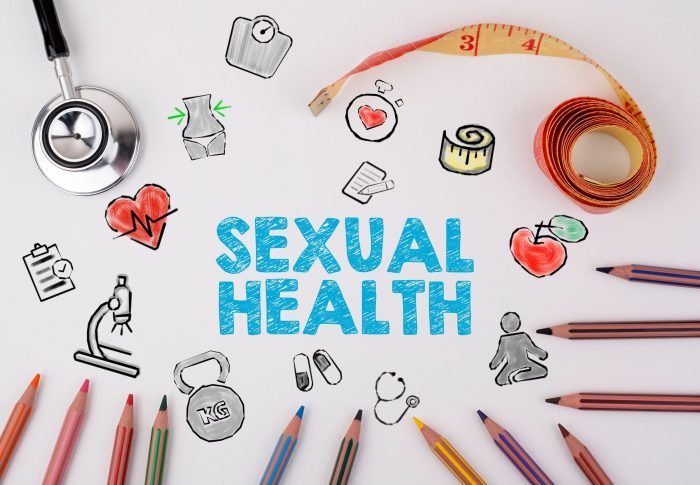Health and sexuality intertwine to form a complex tapestry of physical, mental, and emotional well-being. This exploration delves into the multifaceted nature of sexual health, exploring the influence of cultural norms, the importance of open communication and consent, and the diverse expressions of sexuality across the lifespan.
From understanding the interconnectedness of physical, mental, and emotional well-being in relation to sexuality to navigating the complexities of sexual relationships, this guide provides a comprehensive overview of key topics, including sexual health concerns, reproductive health, and the impact of aging on sexuality.
Sexuality and Identity

Sexuality and gender identity are multifaceted aspects of human experience, encompassing a wide range of expressions and experiences. Understanding the diversity of sexual orientations and gender identities is crucial for fostering inclusivity and promoting well-being for all individuals.
Understanding and promoting healthy sexual practices is crucial for overall well-being. The Texas Health and Human Services Commission, led by the Texas Health and Human Services Commissioner , plays a vital role in ensuring access to comprehensive sexual health education and resources.
This includes providing information on safe sex practices, contraception, and sexually transmitted infections, ultimately contributing to a healthier and more informed population.
Diversity of Sexual Orientations and Gender Identities
Sexual orientation refers to an individual’s enduring physical, romantic, and/or emotional attraction to another person. It encompasses a spectrum of experiences, including:
- Heterosexuality:Attraction to individuals of the opposite gender.
- Homosexuality:Attraction to individuals of the same gender.
- Bisexuality:Attraction to individuals of more than one gender.
- Pansexuality:Attraction to individuals regardless of their gender identity.
- Asexuality:Lack of sexual attraction to any gender.
Gender identity, on the other hand, refers to an individual’s internal sense of their gender. It may align with the sex assigned at birth, or it may differ. Some common gender identities include:
- Cisgender:A person whose gender identity aligns with the sex they were assigned at birth.
- Transgender:A person whose gender identity differs from the sex they were assigned at birth.
- Non-binary:A person whose gender identity falls outside the traditional binary of male and female.
- Genderfluid:A person whose gender identity fluctuates over time.
- Agender:A person who does not identify with any gender.
Challenges and Opportunities, Health and sexuality
Individuals with diverse sexual orientations and gender identities often face significant challenges, including:
- Discrimination and prejudice:This can manifest in various forms, such as verbal harassment, physical violence, and social exclusion.
- Lack of legal protections:In many parts of the world, LGBTQ+ individuals lack legal protections against discrimination and violence.
- Mental health issues:The stigma and discrimination associated with LGBTQ+ identities can lead to increased rates of anxiety, depression, and suicidal thoughts.
- Limited access to healthcare:LGBTQ+ individuals may face barriers to accessing quality healthcare, including specialized care for transgender individuals.
Despite these challenges, there are also opportunities for progress and positive change:
- Increased visibility and advocacy:LGBTQ+ communities are becoming more visible and vocal in advocating for their rights and equality.
- Growing acceptance and understanding:Public attitudes towards LGBTQ+ individuals are gradually shifting towards greater acceptance and understanding.
- Legal advancements:Many countries have implemented legal protections for LGBTQ+ individuals, including same-sex marriage and anti-discrimination laws.
- Support networks and resources:LGBTQ+ individuals have access to a growing network of support groups, organizations, and online resources.
Common Experiences
The following table highlights some key aspects and common experiences associated with various sexual orientations and gender identities:
| Sexual Orientation/Gender Identity | Key Aspects | Common Experiences |
|---|---|---|
| Heterosexuality | Attraction to individuals of the opposite gender. | Often experience societal acceptance and privilege. |
| Homosexuality | Attraction to individuals of the same gender. | May face discrimination, prejudice, and lack of legal protections. |
| Bisexuality | Attraction to individuals of more than one gender. | May experience erasure or invalidation of their identity. |
| Pansexuality | Attraction to individuals regardless of their gender identity. | May face challenges in finding partners who understand their identity. |
| Asexuality | Lack of sexual attraction to any gender. | May feel misunderstood or pressured to conform to societal expectations. |
| Cisgender | Gender identity aligns with sex assigned at birth. | Often experience societal acceptance and privilege. |
| Transgender | Gender identity differs from sex assigned at birth. | May face discrimination, prejudice, and difficulty accessing healthcare. |
| Non-binary | Gender identity falls outside the traditional binary of male and female. | May face challenges in being recognized and respected for their identity. |
| Genderfluid | Gender identity fluctuates over time. | May experience societal pressure to conform to a fixed gender identity. |
| Agender | Does not identify with any gender. | May face difficulty in finding language and terms that accurately reflect their experience. |
Sexuality and Reproduction

Understanding sexuality and reproduction is crucial for making informed decisions about your health and well-being. It encompasses a range of topics, from contraception and its effectiveness to the implications of unplanned pregnancies and sexually transmitted infections (STIs). This section will explore these aspects and provide resources for individuals seeking information on pregnancy, childbirth, and parenting.
Health and sexuality are interconnected, and it’s crucial to have access to resources that address both. The la maestra community health center provides comprehensive healthcare services, including sexual health education and counseling, ensuring that individuals can make informed decisions about their well-being.
Contraception Methods and Effectiveness
Contraception plays a vital role in preventing unintended pregnancies and STIs. There are various methods available, each with its own level of effectiveness and potential side effects.
- Hormonal Methods:These methods, such as birth control pills, patches, and implants, use hormones to prevent ovulation or thicken cervical mucus, making it difficult for sperm to reach the egg. They are highly effective when used correctly and consistently.
- Barrier Methods:These methods, including condoms, diaphragms, and cervical caps, physically block sperm from entering the uterus. While they are not as effective as hormonal methods, they offer protection against STIs.
- Natural Family Planning:This method involves tracking a woman’s menstrual cycle to identify fertile periods and abstaining from intercourse during those times. It requires careful monitoring and is less effective than other methods.
- Long-Acting Reversible Contraception (LARC):This category includes intrauterine devices (IUDs) and implants, which are highly effective and can provide contraception for several years. They are inserted by a healthcare provider and are a long-term option.
- Sterilization:This permanent method involves surgically blocking the fallopian tubes in women or the vas deferens in men. It is highly effective but irreversible.
Implications of Unplanned Pregnancies
Unplanned pregnancies can have significant consequences for individuals and families, including:
- Financial Strain:Raising a child can be expensive, and unplanned pregnancies can put a strain on finances, especially if the parents are not prepared or have limited resources.
- Emotional Stress:The emotional impact of an unplanned pregnancy can be significant, ranging from anxiety and guilt to fear and uncertainty about the future.
- Educational Disruption:Unplanned pregnancies can disrupt educational plans, especially for young people, potentially leading to delayed graduation or career aspirations.
- Health Risks:Unplanned pregnancies can increase the risk of complications for both the mother and the baby, especially if proper prenatal care is not received.
Sexually Transmitted Infections (STIs)
STIs are infections that can be transmitted through sexual contact. They can have a range of symptoms, from mild to severe, and can have long-term health consequences if left untreated.
- Common STIs:Some common STIs include chlamydia, gonorrhea, syphilis, herpes, and human papillomavirus (HPV). These infections can cause various symptoms, including vaginal discharge, pain during urination, sores, and warts.
- Prevention:The best way to prevent STIs is to practice safe sex, including using condoms consistently and getting tested regularly.
- Treatment:Most STIs can be treated with antibiotics or antiviral medications. However, some infections, such as herpes and HPV, cannot be cured but can be managed with medication.
Resources for Pregnancy, Childbirth, and Parenting
For individuals seeking information on pregnancy, childbirth, and parenting, there are numerous resources available:
- Healthcare Providers:Your doctor or midwife can provide comprehensive information and support throughout your pregnancy and postpartum period.
- Government Agencies:Organizations like the Centers for Disease Control and Prevention (CDC) and the World Health Organization (WHO) offer evidence-based resources on pregnancy, childbirth, and parenting.
- Nonprofit Organizations:Many nonprofit organizations, such as Planned Parenthood and the March of Dimes, provide education, support, and resources for families.
- Online Resources:There are numerous websites and apps that offer information on pregnancy, childbirth, and parenting, including BabyCenter, What to Expect, and the American Pregnancy Association.
Final Review: Health And Sexuality

By embracing a holistic approach to health and sexuality, individuals can foster a greater understanding of their own needs and desires, cultivate healthy relationships, and make informed choices that promote overall well-being. This guide serves as a starting point for exploring the intricacies of health and sexuality, encouraging open dialogue, and fostering a culture of respect and understanding.
Query Resolution
What are some common sexual health concerns?
Common concerns include sexually transmitted infections (STIs), unplanned pregnancies, and sexual dysfunction. It’s important to seek regular checkups and engage in safe sex practices to minimize risk.
How can I talk to my partner about sex?
Open and honest communication is crucial. Start by creating a safe and comfortable environment, use “I” statements to express your feelings, and actively listen to your partner’s perspective.
What are some resources for sexual health education?
Many organizations, including Planned Parenthood, the American Sexual Health Association, and Scarleteen, offer reliable information and resources on sexual health.